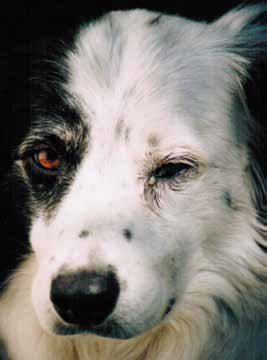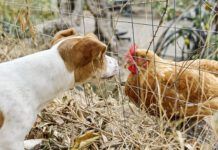A weeping, oozing, gummy, or crusty discharge from one or both of your dog’s eyes might be nothing – a result of the eye’s natural cleansing process – or caused by allergies, infection, illness, or injury. How can you tell what’s normal and what requires veterinary attention?
In a nutshell, if your dog is squinting, blinking, pawing or rubbing at the eyes, or if you see an excessive or bloody discharge, or if just one eye is affected with symptoms like these, your dog may have an eye injury, infection, or damage that needs a veterinarian’s expertise.
CRUSTY EYE DISCHARGE
A crusty discharge is a familiar symptom caused by dried tears, natural oils, dead cells, dust, or mucus. The discharge is often clear or reddish brown and appears in the morning or after a long nap. If it’s consistent from day to day and if your dog isn’t squinting, blinking, or rubbing his eyes, simply wipe the crust away with a warm, damp cloth, sterile gauze, cotton ball, tissue, or canine eye wipe grooming product.
A sterile saline solution from your local pharmacy is a safe preliminary treatment for most eye discharge problems, as is plain warm water. The application of human eyedrops is not recommended for dogs.
With clean hands and damp applicator, start at the inner corner of the eye and wipe gently, moving outward, using soft strokes. Don’t rub directly over the eyeball. Use a separate gauze or cotton ball for the other eye. Clean the eyes daily or as needed. If the crusty discharge is excessive, take a picture and contact your veterinarian.
WATERY EYES
Excessive eye watering, called epiphora, may be caused by allergies, exposure to irritants such as pollen in the eye, rolled-in eyelashes (called entropion), corneal wounds, blocked tear ducts, or increased eye pressure (glaucoma). Mild tearing is not a medical emergency and observing the eyes for a few days while keeping the area dry with a soft cloth is a sensible strategy. If the eyes continue to water, become red and painful, or develop other kinds of discharge, see your veterinarian.
GUMMY, MUCUS EYE DISCHARGE
Gummy, sticky mucus that makes the eyelids stick together can be a symptom of keratoconjunctivitis sicca (KCS) or “dry eye,” an auto-immune disorder that interferes with tear production and results in red, painful eyes or open sores.
Veterinarians use the simple, inexpensive Schirmer Tear Test to differentiate KCS from other conditions that produce eye mucus. It’s important to know what to look for with this condition, since it’s fairly common, very uncomfortable for the dog, and can lead to blindness.
Artificial tears and immune-suppressing drugs like tacrolimus or cyclosporine are often prescribed, and when those treatments fail, surgery is an option. An ongoing gummy, sticky discharge requires medical attention.
COLORED EYE DISCHARGE
A pink or red eye discharge that gets its color from blood can be caused by a recent injury. Some research has shown a connection between the yeast Malassezia pachydermatis and corneal ulcers, which can cause reddish tears. See your veterinarian for this symptom.
A green or yellow eye discharge may come from an eye infection, especially if the eyes look red and appear painful, or the cause may be conjunctivitis, an inflammation of the lining of your dog’s eye. Conjunctivitis can be caused by allergies, injury, tear duct problems, dry eye, birth defects, and even distemper or tumors.
If the eyes are red and the dog blinks frequently, squints, paws at her eyes, or keeps her eyes closed, see your veterinarian. Treatment may include removing an irritant; applying pain medication; treating infection with antibiotics and saline washes; administering antihistamines for allergies; or performing surgery to repair birth defects or tear duct problems.

Tear stains at the inner corners of the eye develop because porphyrin, a pigment in tears, turns reddish brown when exposed to air. Tear stains are sometimes called Poodle stains because they are so obvious on the faces of small, light-coated dogs. If the eyes are otherwise healthy, tear stains are a cosmetic rather than medical problem.
To minimize stains, wipe the eyes with a damp cloth or canine eye-cleaning solution; keep the area dry with a soft cloth or tissue; try a grooming product that reduces tear staining; and keep hair around the eyes trimmed short. Schedule an eye exam if the staining increases, its appearance changes, or your dog’s eyes become red and painful.
Flat-faced Bulldogs, Boxers, Pekingese, and Pugs have shallower eye sockets and more protruding eyes than other breeds; the increased exposure to the air means the eyes require more tears to keep them lubricated. Another problem these dogs can display are inwardly rolled eyelids, which can cause lash irritation, or the lids don’t close fully, which may require corrective surgery.
Breeds with loose facial skin (including Saint Bernards, Bloodhounds, Cocker Spaniels, Beagles, and some terriers) may have eyelids that roll outward or have “cherry eye,” which occurs when an eyelid gland falls out of position. Surgery may be needed for those conditions, although antibiotics and steroids are a common first treatment.
HOW TO GIVE A DOG EYE DROPS
If your dog’s eyes need more than a gentle wipe with saline or warm water, learn how to administer eye drops or ointments efficiently.
- Clear debris from around the eyes and dry the area with a clean, soft cloth.
- To apply eye drops, tilt the dog’s head back slightly. Rest a hand on your dog’s head to keep the applicator from accidentally hitting the dog’s eye, and squeeze drops into the upper part of the eye.
- To apply ointment, rest your hand on the dog’s head, pull the dog’s lower eyelid down to create a pocket, then squeeze a ribbon of ointment inside the lower lid.
- Your veterinarian can show you how to administer eye medication, as can online veterinary videos, and a friend or groomer may be able to help.
- Follow instructions for frequency and quantity of applications.
- Help your dog relax before treatment. For example, apply a pressure wrap such as an Anxiety Wrap (anxietywrap.com) or ThunderShirt (thunderworks.com), wrap a small dog in a towel, have rewards handy, or gently brush or massage the dog. See “Tricks to Giving Your Dog Eye Medication,” WDJ May 2014.
PREVENTING EYE INFECTIONS IN DOGS
To catch problems early, check your dog’s eyes every day so you’ll notice unusual symptoms when they’re easiest to treat. Keep the eye area as clean and dry as possible. If your dog’s symptoms are unusual, fail to improve, or get worse, call your veterinarian.
Grooming products that treat tear stains can be drops, powders, ointments, nutritional supplements, and even combs. A tear-stain comb (petpost.us) resembles a flea comb with narrower teeth that gently remove debris from fine hair near the eye.
Some tear-stain products contain eyebright, bilberry, dandelion, German chamomile, or other traditional herbal eye treatments.
Keeping hair around the eyes and nose as short as possible and keeping the face clean and dry are essential first steps. Contact lens solution can be used to clean around the eyes (not applied to the eyes) because its boric acid oxidizes the iron in porphyrins, lightening the color of tear stains.
Some probiotics are said to treat tear stains, though that use has not been proven. Still, experimenting with nutritional supplements and improving the quality of your dog’s diet may be helpful.
Search online for tear-stain grooming products, compare ingredients, study reviews, or check with your veterinarian or groomer to help find a treatment that will help your dog.






